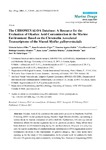Mostrar o rexistro simple do ítem
The CHROMEVALOA Database: A Resource for the Evaluation of Okadaic Acid Contamination in the Marine Environment Based on the Chromatin-Associated Transcriptome of the Mussel Mytilus galloprovincialis
| dc.contributor.author | Suárez-Ulloa, Victoria | |
| dc.contributor.author | Fernández-Tajes, Juan | |
| dc.contributor.author | Aguiar-Pulido, Vanessa | |
| dc.contributor.author | Rivera-Casas, Ciro | |
| dc.contributor.author | González-Romero, Rodrigo | |
| dc.contributor.author | Ausio, Juan | |
| dc.contributor.author | Méndez, Josefina | |
| dc.contributor.author | Dorado, Julián | |
| dc.contributor.author | Eirín-López, J.M. | |
| dc.date | 2013 | |
| dc.date.accessioned | 2017-09-26T08:19:03Z | |
| dc.date.available | 2017-09-26T08:19:03Z | |
| dc.identifier.citation | Marine Drugs 2013, Vol. 11, Pages 830-841 | |
| dc.identifier.issn | 1660-3397 | |
| dc.identifier.uri | http://hdl.handle.net/2183/19530 | |
| dc.description.abstract | Okadaic Acid (OA) constitutes the main active principle in Diarrhetic Shellfish Poisoning (DSP) toxins produced during Harmful Algal Blooms (HABs), representing a serious threat for human consumers of edible shellfish. Furthermore, OA conveys critical deleterious effects for marine organisms due to its genotoxic potential. Many efforts have been dedicated to OA biomonitoring during the last three decades. However, it is only now with the current availability of detailed molecular information on DNA organization and the mechanisms involved in the maintenance of genome integrity, that a new arena starts opening up for the study of OA contamination. In the present work we address the links between OA genotoxicity and chromatin by combining Next Generation Sequencing (NGS) technologies and bioinformatics. To this end, we introduce CHROMEVALOAdb, a public database containing the chromatin-associated transcriptome of the mussel Mytilus galloprovincialis (a sentinel model organism) in response to OA exposure. This resource constitutes a leap forward for the development of chromatin-based biomarkers, paving the road towards the generation of powerful and sensitive tests for the detection and evaluation of the genotoxic effects of OA in coastal areas. | es_ES |
| dc.description.sponsorship | Ministerio de Economía y Competividad; CGL2011-24812 | es_ES |
| dc.description.sponsorship | Xunta de Galicia; 10-PXIB-103-077-PR | es_ES |
| dc.description.sponsorship | Ministerio de Economía y Competividad; AGL2008-05346 | es_ES |
| dc.description.sponsorship | Ministerio de Economía y Competividad; AGL2012-30897 | es_ES |
| dc.description.sponsorship | Natural Sciences and Engineering Research Council of Canada; NSERC-46399-12 | es_ES |
| dc.description.sponsorship | Xunta de Galicia; CN2012/127 | es_ES |
| dc.language.iso | eng | |
| dc.publisher | Multidisciplinary Digital Publishing Institute | |
| dc.relation.uri | http://dx.doi.org/10.3390/md11030830 | es_ES |
| dc.rights | Reconocimiento 3.0 | es_ES |
| dc.rights.uri | http://creativecommons.org/licenses/by/3.0/ | |
| dc.subject | Okadaic acid | es_ES |
| dc.subject | Harmful algae blooms | es_ES |
| dc.subject | Mussel | es_ES |
| dc.subject | Chromatin | es_ES |
| dc.subject | Databases | es_ES |
| dc.subject | Mytilus galloprovincialis | es_ES |
| dc.title | The CHROMEVALOA Database: A Resource for the Evaluation of Okadaic Acid Contamination in the Marine Environment Based on the Chromatin-Associated Transcriptome of the Mussel Mytilus galloprovincialis | |
| dc.type | info:eu-repo/semantics/article | |
| dc.rights.access | info:eu-repo/semantics/openAccess | |
| UDC.journalTitle | Marine Drugs | |
| UDC.volume | 11 | |
| UDC.issue | 3 | |
| UDC.startPage | 830 | |
| UDC.endPage | 841 |






